 Rishi Sunak delivered his 2021 UK Budget on 3 March. It illustrates the delicate balancing act that governments in many countries face as the effects of the coronavirus pandemic persist and public-sector debt soars. He announced that he would continue supporting the economy through various forms of government expenditure and tax relief, but also announced tax rises over the medium term to begin addressing the massively increased public-sector debt.
Rishi Sunak delivered his 2021 UK Budget on 3 March. It illustrates the delicate balancing act that governments in many countries face as the effects of the coronavirus pandemic persist and public-sector debt soars. He announced that he would continue supporting the economy through various forms of government expenditure and tax relief, but also announced tax rises over the medium term to begin addressing the massively increased public-sector debt.
Key measures of support for people and businesses include:
- An extension of the furlough scheme until the end of September, with employees continuing to be paid 80% of their wages for hours they cannot work, but with employers having to contribute 10% in July and 20% in August and September.
- Support for the self-employed also extended until September, with the scheme being widened to make 600 000 more self-employed people eligible.
- The temporary £20 increase to Universal Credit, introduced in April last year and due to end on 31 March this year, to be extended to the end of September.
- Stamp duty holiday on house purchases in England and Northern Ireland, under which there is no tax liability on sales of less than £500 000, extended from the end of March to the end of June.
- An additional £1.65bn to support the UK’s vaccination rollout.
- VAT rate for hospitality firms to be maintained at the reduced 5% rate until the end of September and then raised to 12.5% (rather than 20%) for a further six months.
- A range of grants for the arts, sport, shops , other businesses and apprenticeships.
- Business rates holiday for hospitality firms in England extended from the end of March to the end of June and then with a discount of 66% until April 2022.
- 130% of investment costs can be offset against tax – a new tax ‘super-deduction’.
- No tax rises on alcohol, tobacco or fuel.
- New UK Infrastructure Bank to be set up in Leeds with £12bn in capital to support £40bn worth of public and private projects.
- Increased grants for devolved nations and grants for 45 English towns.
It has surprised many commentators that there was no announcement of greater investment in the NHS or more money for social care beyond the £3bn for the NHS and £1bn for social care announced in the November Spending Review. The NHS England budget will fall from £148bn in 2020/21 to £139bn in 2021/22.
Effects on borrowing and GDP
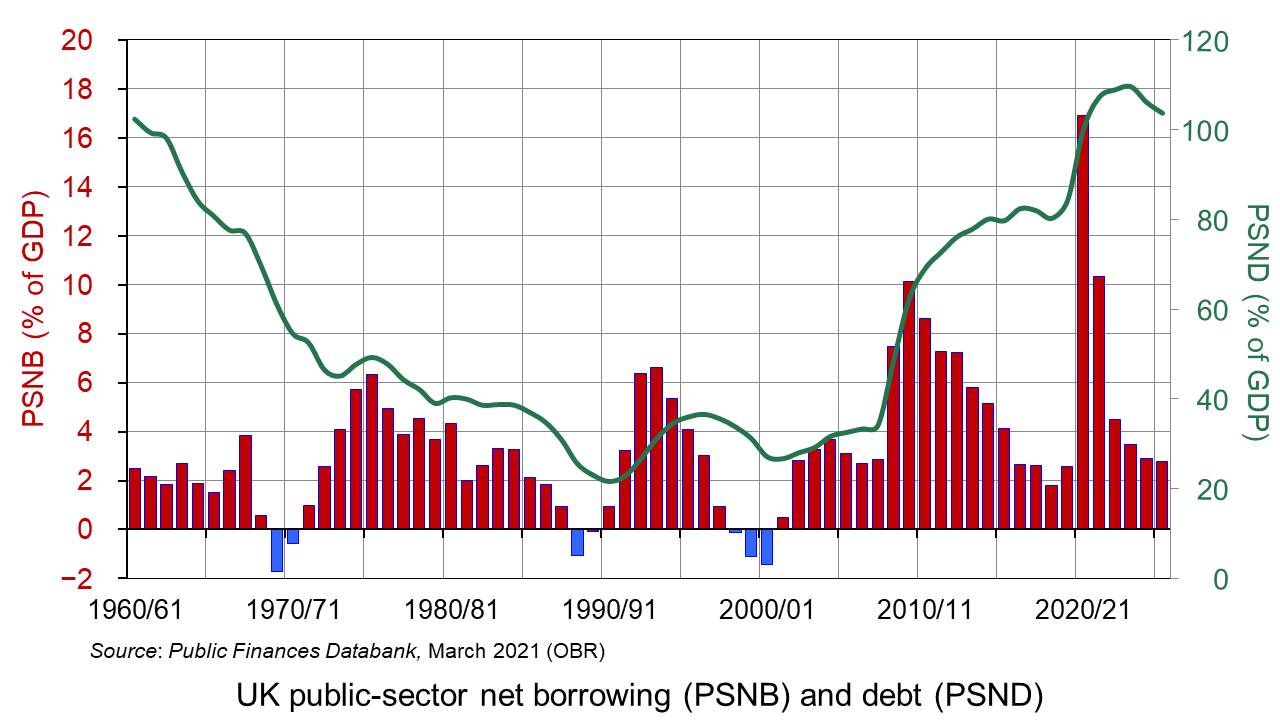
The net effect of these measures for the two financial years 2020 to 2022 is forecast by the Treasury to be an additional £37.5bn of government expenditure and a £27.3bn reduction in tax revenue (see Table 2.1 in Budget 2021). This takes the total support since the start of the pandemic to £352bn across the two years.
According to the OBR, this will result in public-sector borrowing being 16.9% of GDP in 2020/21 (the highest since the Second World War) and 10.3% of GDP in 2021/22. Public-sector debt will be 107.4% of GDP in 2021/22, rising to 109.7% in 2023/24 and then falling to 103.8% in 2025/26.
 Faced with this big increase in borrowing, the Chancellor also announced some measures to raise tax revenue beginning in two years’ time when, hopefully, the economy will have grown. Indeed, the OBR forecasts that GDP will grow by 4.0% in 2021 and 7.3% in 2022, with the growth rate then settling at around 1.7% from 2023 onwards. He announced that:
Faced with this big increase in borrowing, the Chancellor also announced some measures to raise tax revenue beginning in two years’ time when, hopefully, the economy will have grown. Indeed, the OBR forecasts that GDP will grow by 4.0% in 2021 and 7.3% in 2022, with the growth rate then settling at around 1.7% from 2023 onwards. He announced that:
- Corporation tax on company profits over £250 000 will rise from 19% to 25% in April 2023. Rates for profits under £50 000 will remain at the current rate of 19%, with the rate rising in stages as profits rise above £50 000.
- Personal income tax thresholds will be frozen from 2022/23 to 2025/26 at £12 570 for the basic 20% marginal rate and at £50 270 for the 40% marginal rate. This will increase the average tax rate as people’s nominal incomes rise.
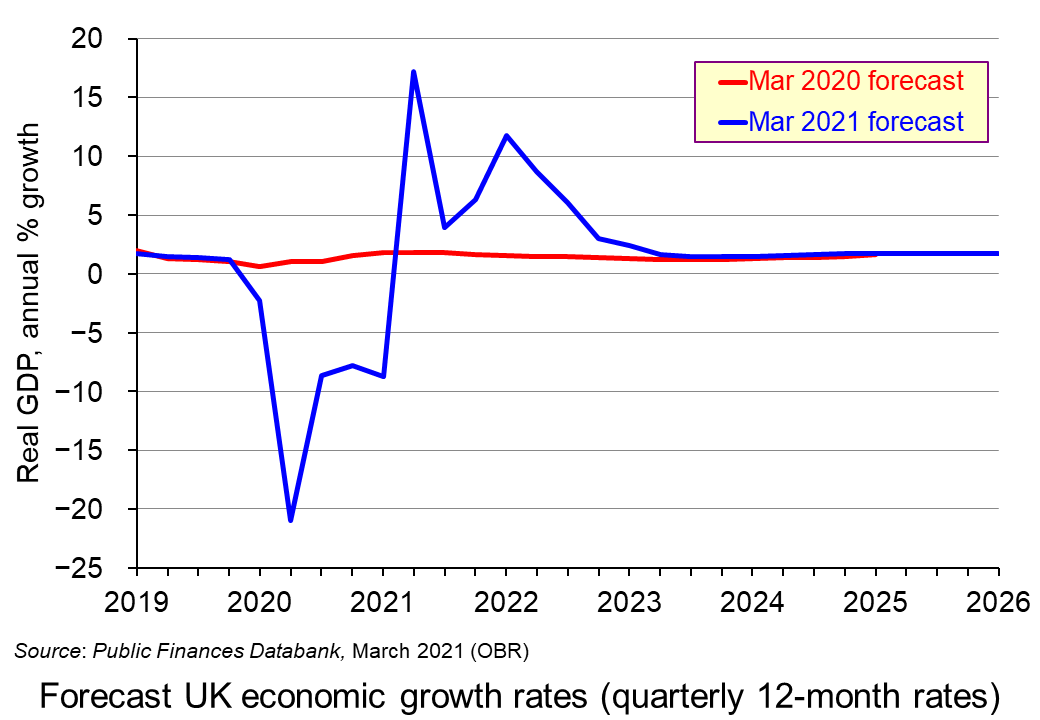 The policy of a fiscal boost now and a fiscal tightening later might pose political difficulties for the government as this does not fit with the electoral cycle. Normally, politicians like to pursue tighter policies in the early years of the government only to loosen policy with various giveaways as the next election approaches. With Rishi Sunak’s policies, the opposite is the case, with fiscal policy being tightened as the 2024 election approaches.
The policy of a fiscal boost now and a fiscal tightening later might pose political difficulties for the government as this does not fit with the electoral cycle. Normally, politicians like to pursue tighter policies in the early years of the government only to loosen policy with various giveaways as the next election approaches. With Rishi Sunak’s policies, the opposite is the case, with fiscal policy being tightened as the 2024 election approaches.
Another issue is the high degree of uncertainty in the forecasts on which he is basing his policies. If there is another wave of the coronavirus with a new strain resistant to the vaccines or if the scarring effects of the lockdowns are greater, then growth could stall. Or if inflation begins to rise and the Bank of England feels it must raise interest rates, then this would suppress growth. With lower growth, the public-sector deficit would be higher and the government would be faced with the dilemma of whether it should raise taxes, cut government expenditure or accept higher borrowing.
What is more, there are likely to be huge pressures on the government to increase public spending, not cut it by £4bn per year in the medium term as he plans. As Paul Johnson of the IFS states:
In reality, there will be pressures from all sorts of directions. The NHS is perhaps the most obvious. Further top-ups seem near-inevitable. Catching up on lost learning in schools, dealing with the backlog in our courts system, supporting public transport providers, and fixing our system for social care funding would all require additional spending. The Chancellor’s medium-term spending plans simply look implausibly low.
Articles and Briefings
- Budget 2021: Key points at-a-glance
BBC News (3/3/21)
- Budget 2021: Full round-up of what Chancellor Rishi Sunak has announced
MoneySavingExpert, Callum Mason (3/3/21)
- Budget 2021 at a glance: The key points from Chancellor Rishi Sunak’s speech
This is Money, Alex Sebastian (3/3/21)
 Budget 2021
Budget 2021IFS (3/3/21)
- Rishi Sunak delivers spend now, tax later Budget to kickstart UK economy
Financial Times, Jim Pickard, Chris Giles and George Parker (3/3/21)
- Swifter and more sustained? What did we learn about the UK’s economic outlook from Rishi Sunak’s Budget?
Independent. Ben Chu (3/3/21)
- Spending fast, taxing slow: Briefing Note
Resolution Foundation, Torsten Bell, Mike Brewer, Nye Cominetti, Karl Handscomb, Kathleen Henehan, Lindsay Judge, Jack Leslie, Charlie McCurdy, Cara Pacitti, Hannah Slaughter, James Smith, Gregory Thwaites & Daniel Tomlinson (4/3/21)
- JRF Spring Budget 2021 analysis and briefing
Joseph Rowntree Foundation, Dave Innes and Katie Schmuecker (4/3/21)
- NHS, social care and most vulnerable ‘betrayed’ by Sunak’s budget
The Guardian, Robert Booth ,Patrick Butler and Denis Campbell (3/3/21)
- Spend now, pay later: Sunak flags major tax rises as Covid bill tops £400bn
The Guardian, Heather Stewart and Larry Elliott (3/3/21)
- Rishi Sunak digs in for battle against financial cost of Covid
The Guardian, Larry Elliott (3/3/21)
- Tax and spending experts say Sunak’s budget doesn’t add up
The Guardian, Larry Elliott and Heather Stewart (4/3/21)
 Budget 2021: Prepare for a dramatic rollercoaster ride after chancellor’s give-then-take budget
Budget 2021: Prepare for a dramatic rollercoaster ride after chancellor’s give-then-take budgetSky News, Ed Conway (3/3/21)
Official documents and data
Questions
- Assess the wisdom of the timing of the changes in tax and government expenditure announced in the Budget.
- Universal credit was increased by £20 per week in April 2020 and is now due to fall back to its previous level in October 2021. Have the needs of people on Universal Credit increased during the pandemic and, if so, are they likely to return to their previous level in October?
- In the past, the government argued that reductions in the rate of corporation tax would increase tax revenue. The Chancellor now argues that increasing it from 19% to 25% will increase tax revenue. Examine the justification for this increase and the significance of relative profit tax rates between countries.
- Investigate the effects on the public finances of the pandemic and government fiscal policy in two other countries. How do the effects compare with those in the UK?
- The Joseph Rowntree Foundation looks at poverty in the UK and policies to tackle it. It set five tests for the Budget. Examine its Budget Analysis and consider whether these tests have been met.
 On 25 November, the UK government published its Spending Review 2020. This gives details of estimated government expenditure for the current financial year, 2020/21, and plans for government expenditure and the likely totals for 2021/22.
On 25 November, the UK government published its Spending Review 2020. This gives details of estimated government expenditure for the current financial year, 2020/21, and plans for government expenditure and the likely totals for 2021/22.
The focus of the Review is specifically on the effects of and responses to the coronavirus pandemic. It does not consider the effects of Brexit, with or without a trade deal, or plans for taxation. The Review is based on forecasts by the Office for Budget Responsibility (OBR). Because of the high degree of uncertainty over the spread of the disease and the timing and efficacy of vaccines, the OBR gives three forecast values for most variables – pessimistic, central and optimistic.
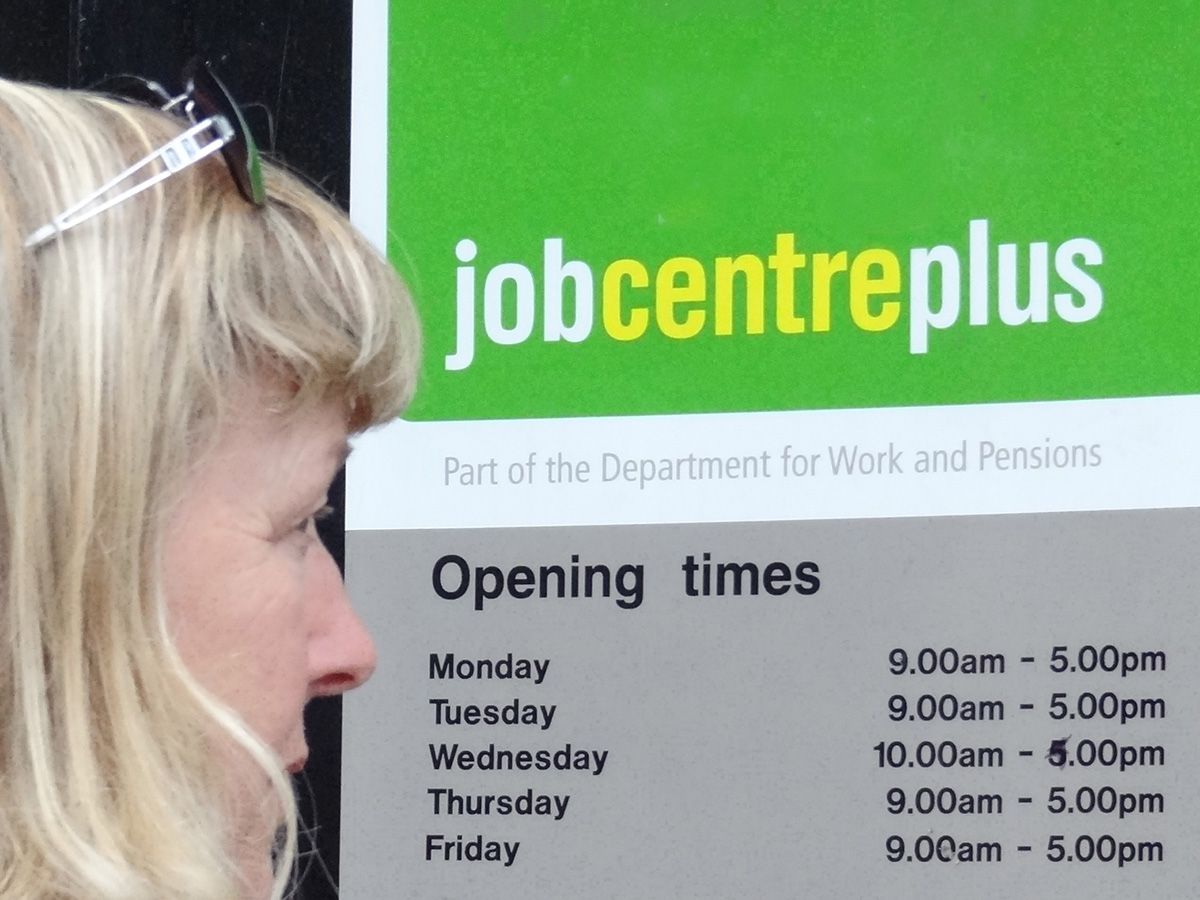 According to the central forecast, real GDP is set to decline by 11.3% in 2020, the largest one-year fall since the Great Frost of 1709. The economy is then set to ‘bounce back’ (somewhat), with GDP rising by 5.2% in 2021.
According to the central forecast, real GDP is set to decline by 11.3% in 2020, the largest one-year fall since the Great Frost of 1709. The economy is then set to ‘bounce back’ (somewhat), with GDP rising by 5.2% in 2021.
Unemployment will rise from 3.9% in 2019 to a peak of 7.5% in mid-2021, after the furlough scheme and other support for employers is withdrawn.
This blog focuses at the impact on government borrowing and debt and the implications for the future – both the funding of the debt and ways of reducing it.
Soaring government deficits and debt
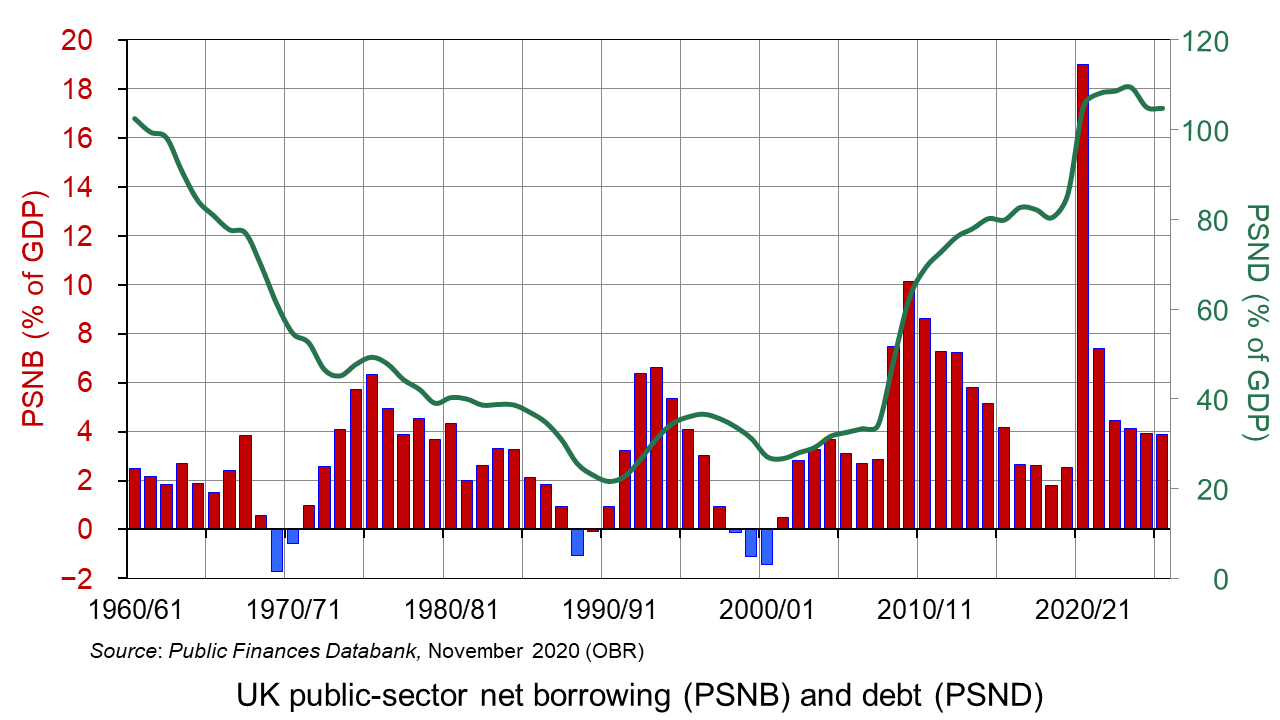
Government expenditure during the pandemic has risen sharply through measures such as the furlough scheme, the Self-Employment Income Support Scheme and various business loans. This, combined with falling tax revenue, as incomes and consumer expenditure have declined, has led to a rise in public-sector net borrowing (PSNB) from 2.5% of GDP in 2019/20 to a central forecast of 19% for 2020/21 – the largest since World War II. By 2025/26 it is still forecast to be 3.9% of GDP. The figure has also been pushed up by a fall in nominal GDP for 2020/21 (the denominator) by nearly 7%. (Click here for a PowerPoint of the above chart.)
The high levels of PSNB are pushing up public-sector net debt (PSNB). This is forecast to rise from 85.5% of GDP in 2019/20 to 105.2% in 2020/21, peaking at 109.4% in 2023/24.
The exceptionally high deficit and debt levels will mean that the government misses by a very large margin its three borrowing and debt targets set out in the latest (Autumn 2016) ‘Charter for Budget Responsibility‘. These are:
- to reduce cyclically-adjusted public-sector net borrowing to below 2% of GDP by 2020/21;
- for public-sector net debt as a percentage of GDP to be falling in 2020/21;
- for overall borrowing to be zero or in surplus by 2025/26.
But, as the Chancellor said in presenting the Review:
Our health emergency is not yet over. And our economic emergency has only just begun. So our immediate priority is to protect people’s lives and livelihoods.
Putting the public finances on a sustainable footing
Running a large budget deficit in an emergency is an essential policy for dealing with the massive decline in aggregate demand and for supporting those who have, or otherwise would have, lost their jobs. But what of the longer-term implications? What are the options for dealing with the high levels of debt?
1. Raising taxes. This tends to be the preferred approach of those on the left, who want to protect or improve public services. For them, the use of higher progressive taxes, such as income tax, or corporation tax or capital gains tax, are a means of funding such services and of providing support for those on lower incomes. There has been much discussion of the possibility of finding a way of taxing large tech companies, which are able to avoid taxes by declaring very low profits by diverting them to tax havens.
2. Cutting government expenditure. This is the traditional preference of those on the right, who prefer to cut the overall size of the state and thus allow for lower taxes. However, this is difficult to do without cutting vital services. 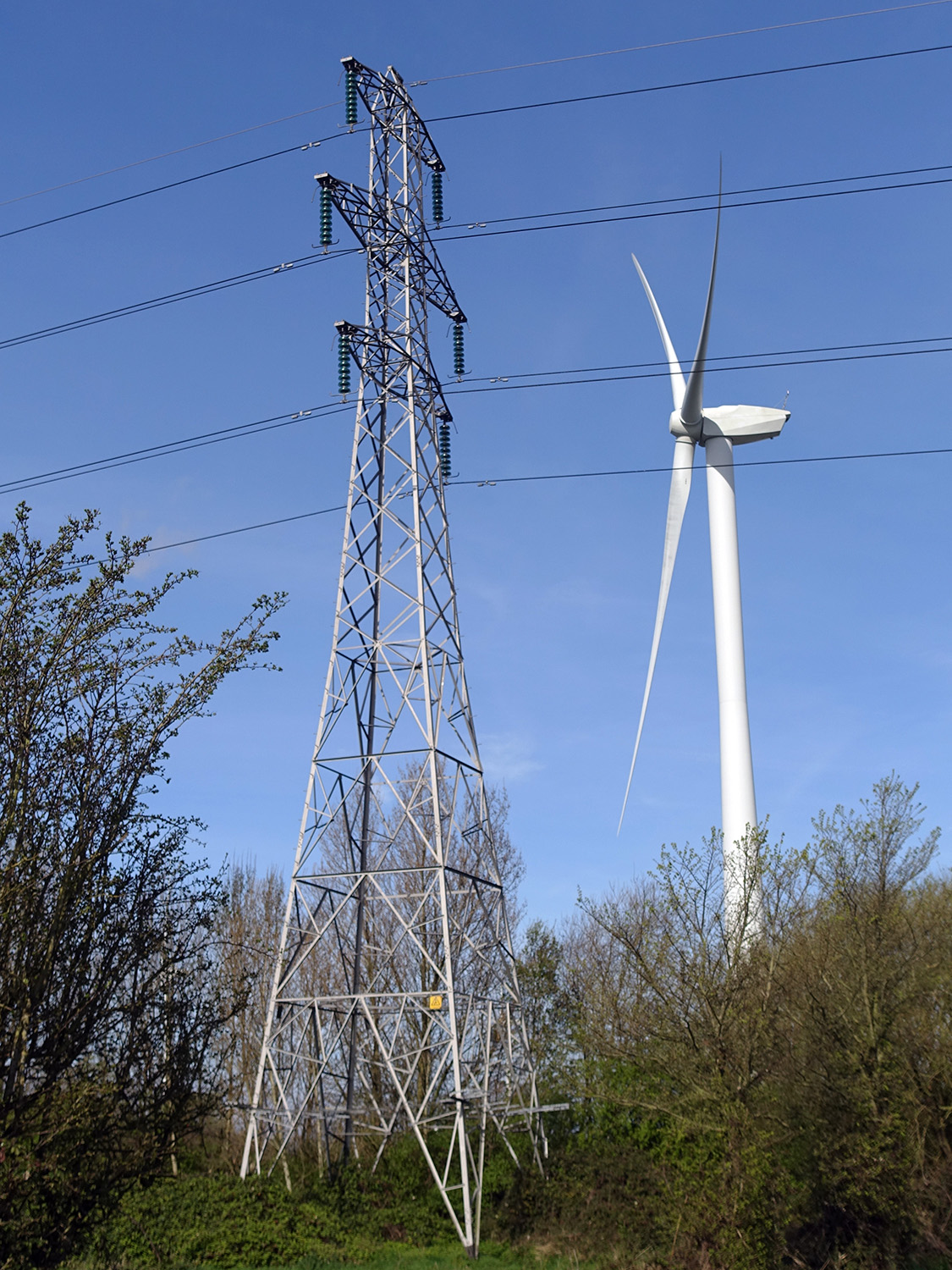 Indeed, there is pressure to have higher government expenditure over the longer term to finance infrastructure investment – something supported by the Conservative government.
Indeed, there is pressure to have higher government expenditure over the longer term to finance infrastructure investment – something supported by the Conservative government.
A downside of either of the above is that they squeeze aggregate demand and hence may slow the recovery. There was much discussion after the financial crisis over whether ‘austerity policies’ hindered the recovery and whether they created negative supply-side effects by dampening investment.
3. Accepting higher levels of debt into the longer term. This is a possible response as long as interest rates remain at record low levels. With depressed demand, loose monetary policy may be sustainable over a number of years. Quantitative easing depresses bond yields and makes it cheaper for governments to finance borrowing. Servicing high levels of debt may be quite affordable.
The problem is if inflation begins to rise. Even with lower aggregate demand, if aggregate supply has fallen faster because of bankruptcies and lack of investment, there may be upward pressure on prices. The Bank of England may have to raise interest rates, making it more expensive for the government to service its debts.
Another problem with not reducing the debt is that if another emergency occurs in the future, there will be less scope for further borrowing to support the economy.
 4. Higher growth ‘deals’ with the deficit and reduces debt. In this scenario, austerity would be unnecessary. This is the ‘golden’ scenario – for the country to grow its way out of the problem. Higher output and incomes leads to higher tax revenues, and lower unemployment leads to lower expenditure on unemployment benefits. The crucial question is the relationship between aggregate demand and supply. For growth to be sustainable and shrink the debt/GDP ratio, aggregate demand must expand steadily in line with the growth in aggregate supply. The faster aggregate supply can grow, the faster can aggregate demand. In other words, the faster the growth in potential GDP, the faster can be the sustainable rate of growth of actual GDP and the faster can the debt/GDP ratio shrink.
4. Higher growth ‘deals’ with the deficit and reduces debt. In this scenario, austerity would be unnecessary. This is the ‘golden’ scenario – for the country to grow its way out of the problem. Higher output and incomes leads to higher tax revenues, and lower unemployment leads to lower expenditure on unemployment benefits. The crucial question is the relationship between aggregate demand and supply. For growth to be sustainable and shrink the debt/GDP ratio, aggregate demand must expand steadily in line with the growth in aggregate supply. The faster aggregate supply can grow, the faster can aggregate demand. In other words, the faster the growth in potential GDP, the faster can be the sustainable rate of growth of actual GDP and the faster can the debt/GDP ratio shrink.
One of the key issues is the degree of economic ‘scarring’ from the pandemic and the associated restrictions on economic activity. The bigger the decline in potential output from the closure of firms and the greater the deskilling of workers who have been laid off, the harder it will be for the economy to recover and the longer high deficits are likely to persist.
Another issue is the lack of labour productivity growth in the UK in recent years. If labour productivity does not increase, this will severely restrict the growth in potential output. Focusing on training and examining incentives, work practices and pay structures are necessary if productivity is to rise significantly. So too is finding ways to encourage firms to increase investment in new technologies.
Podcast and videos
Articles
- Initial reaction from IFS researchers on Spending Review 2020 and OBR forecasts
IFS Press Release, Paul Johnson, Carl Emmerson, Ben Zaranko, Tom Waters and Isabel Stockton (25/11/200
- Rishi Sunak is likely to increase spending – which means tax rises will follow
IFS, Newspaper Article, Paul Johnson (23/11/20)
- Economic and Fiscal Outlook Executive Summary
OBR (25/11/20)
- UK’s Sunak says public finances are on ‘unsustainable’ path
Reuters, David Milliken (26/11/20)
- Rishi Sunak warns ‘economic emergency has only just begun’
BBC News, Szu Ping Chan (25/11/20)
- UK will need £27bn of spending cuts or tax rises, watchdog warns
The Guardian, Phillip Inman (25/11/20)
- What is tomorrow’s Spending Review all about?
The Institute of Chartered Accountants in England and Wales (24/11/20)
- Spending Review 2020: the experts react
The Conversation, Drew Woodhouse, Ernestine Gheyoh Ndzi, Jonquil Lowe, Anupam Nanda, Alex de Ruyter and Simon J. Smith (25/11/20)
OBR Data
Questions
- What is the significance of the relationship between the rate of economic growth and the rate of interest for financing public-sector debt over the longer term?
- What can the government do to encourage investment in the economy?
- Using OBR data, find out what has happened to the output gap over the past few years and what is forecast to happen to it over the next five years. Explain the significance of the figures.
- Distinguish between demand-side and supply-side policies. How would you characterise the policies to tackle public-sector net debt in terms of this distinction? Do the policies have a mixture of demand- and supply-side effects?
- Choose two other developed countries. Examine how their their public finances have been affected by the coronavirus pandemic and the policies they are adopting to tackle the economic effects of the pandemic.
 Back in June, we examined the macroeconomic forecasts of the three agencies, the IMF, the OECD and the European Commission, all of which publish forecasts every six months. The IMF has recently published its latest World Economic Outlook (WEO) and its accompanying database. Unlike the April WEO, which, given the huge uncertainty surrounding the pandemic and its economic effects, only forecast as far as 2021, the latest version forecasts as far ahead as 2025.
Back in June, we examined the macroeconomic forecasts of the three agencies, the IMF, the OECD and the European Commission, all of which publish forecasts every six months. The IMF has recently published its latest World Economic Outlook (WEO) and its accompanying database. Unlike the April WEO, which, given the huge uncertainty surrounding the pandemic and its economic effects, only forecast as far as 2021, the latest version forecasts as far ahead as 2025.
 In essence the picture is similar to that painted in April. The IMF predicts a large-scale fall in GDP and rise in unemployment, government borrowing and government debt for 2020 (compared with 2019) across virtually all countries.
In essence the picture is similar to that painted in April. The IMF predicts a large-scale fall in GDP and rise in unemployment, government borrowing and government debt for 2020 (compared with 2019) across virtually all countries.
World real GDP is predicted to fall by 4.4%. For many countries the fall will be much steeper. In the UK, GDP is predicted to fall by 9.8%; in the eurozone, by 8.3%; in India, by 10.3%; in Italy, by 10.8%; in Spain, by 12.8%. 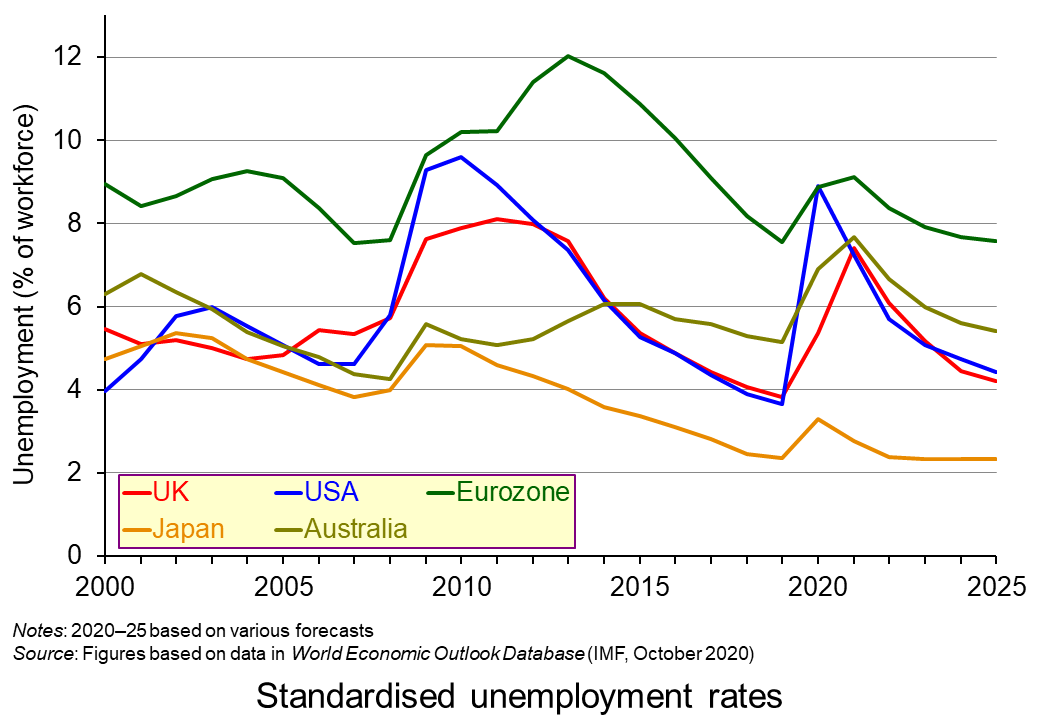 There will then be somewhat of a ‘bounce back’ in GDP in 2021, but not to the levels of 2019. World real GDP is predicted to rise by 5.2% in 2021. (Click here for a PowerPoint of the growth chart.)
There will then be somewhat of a ‘bounce back’ in GDP in 2021, but not to the levels of 2019. World real GDP is predicted to rise by 5.2% in 2021. (Click here for a PowerPoint of the growth chart.)
Unemployment will peak in some countries in 2020 and in others in 2021 depending on the speed of recovery from recession and the mobility of labour. (Click here for a PowerPoint of the unemployment chart.)
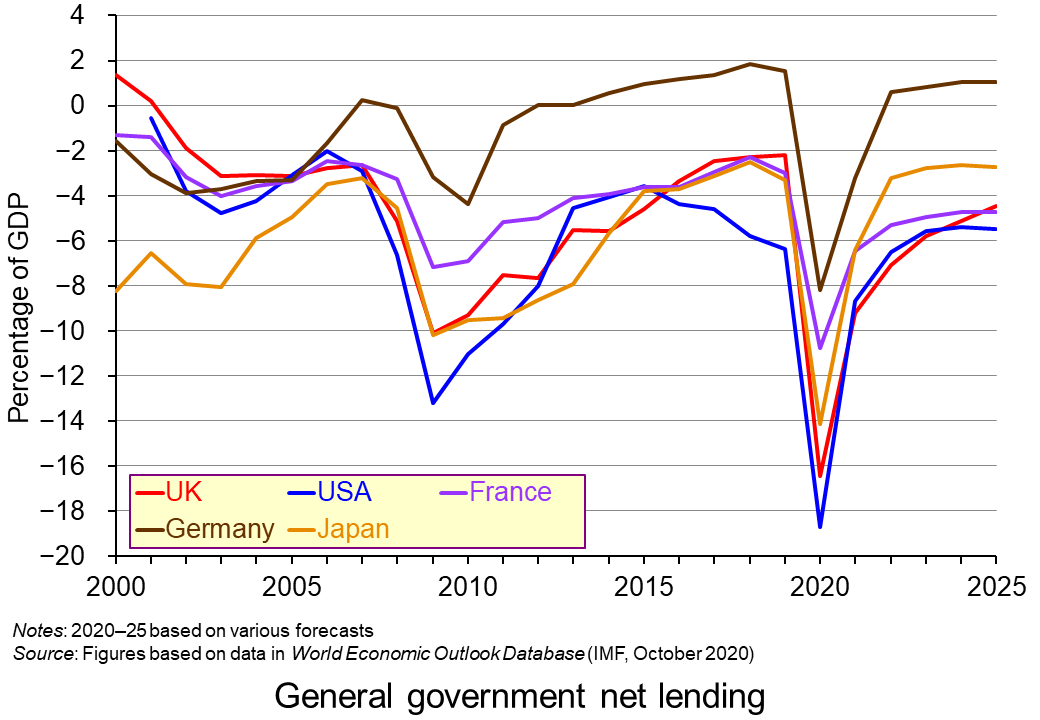 Inflation is set to fall from already low levels. Several countries are expected to see falling prices.
Inflation is set to fall from already low levels. Several countries are expected to see falling prices.
Government deficits (negative net lending) will be sharply higher in 2020 as a result of government measures to support workers and firms affected by lockdowns and falling demand. Governments will also receive reduced tax revenues. (Click here for a PowerPoint of the general government net lending chart.)
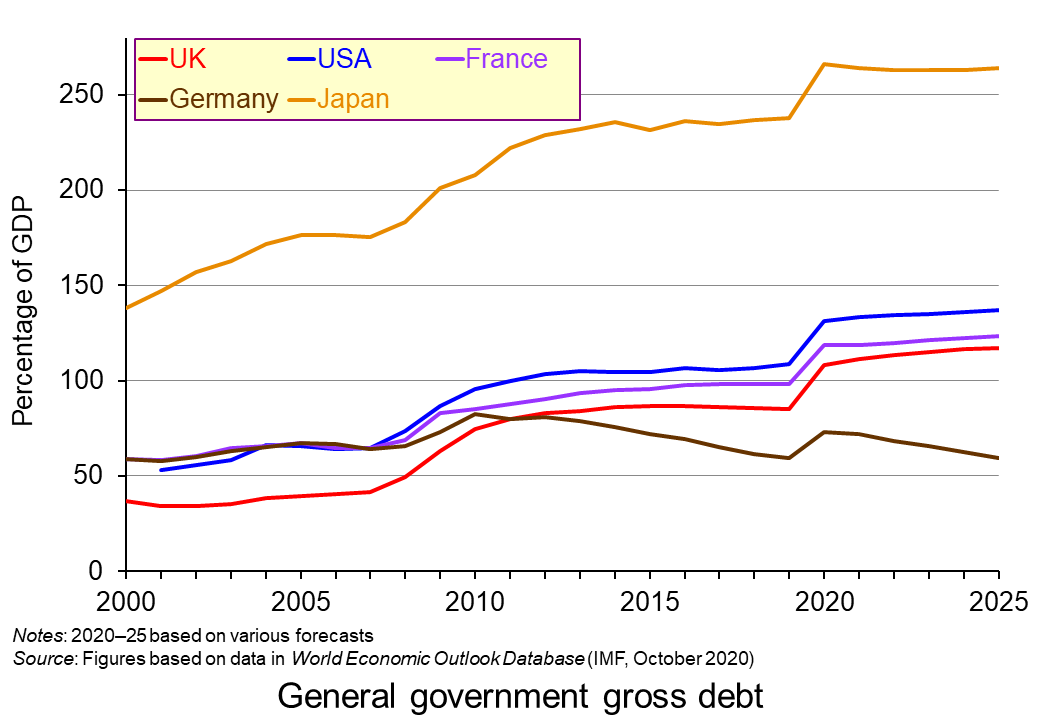 Government debt will consequently rise more rapidly. Deficits are predicted to fall in 2021 as economies recover and hence the rise in debt will slow down or in some cases, such as Germany, even fall. (Click here for a PowerPoint of the general government gross debt chart.)
Government debt will consequently rise more rapidly. Deficits are predicted to fall in 2021 as economies recover and hence the rise in debt will slow down or in some cases, such as Germany, even fall. (Click here for a PowerPoint of the general government gross debt chart.)
After the rebound in 2021, global growth is then expected to slow to around 3.5% by 2025. This compares with an average of 3.8% from 2000 to 2019. Growth of advanced economies is expected to slow to 1.7%. It averaged 1.9% from 2000 to 2019. For emerging market and developing countries it is expected to slow to 4.7% from an average of 5.7% from 2000 to 2019. These figures suggest some longer-term scarring effects from the pandemic.
Uncertainties
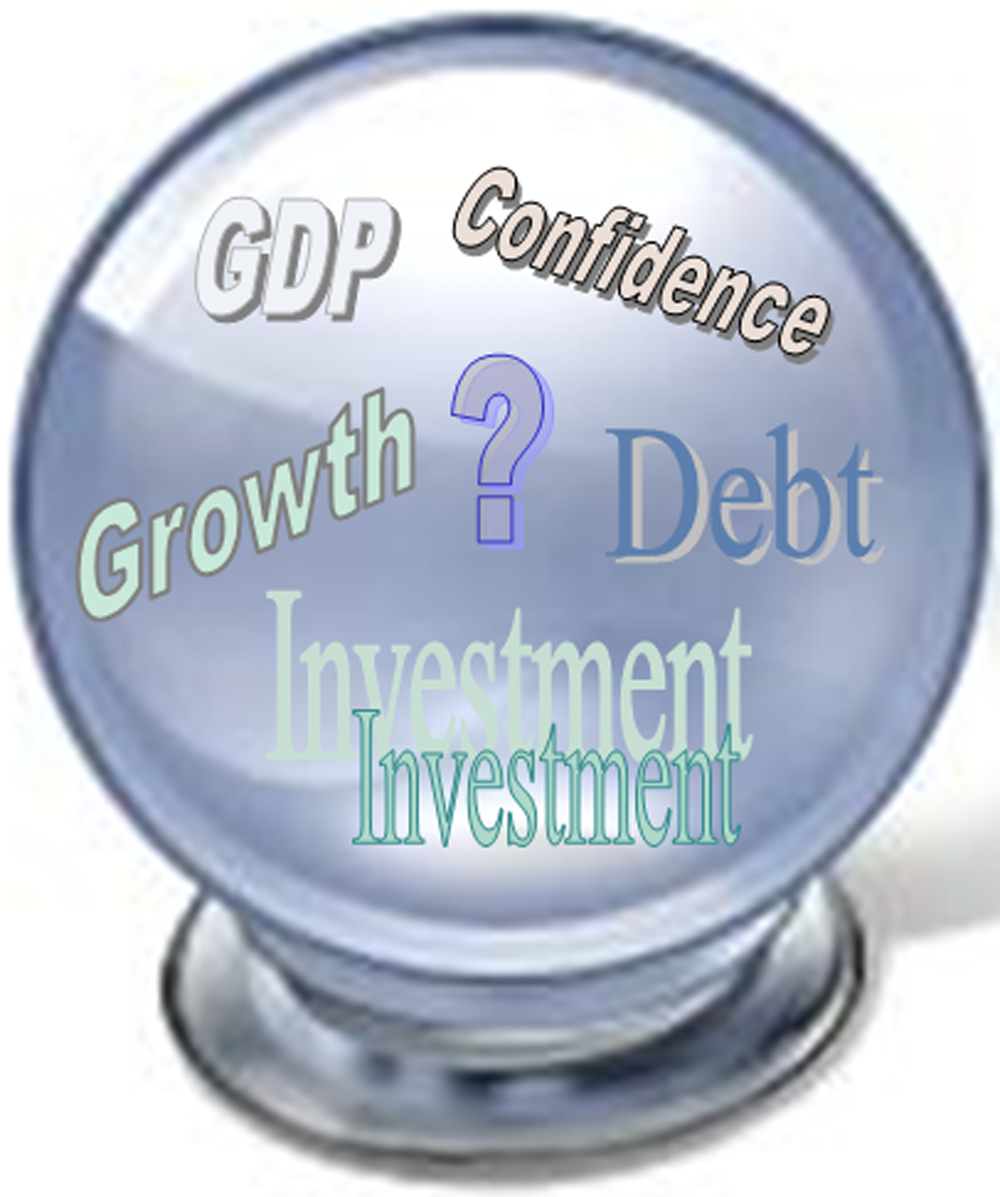 In the short term, the greatest uncertainty concerns the extent of the second wave, the measures put in place to contain the spread of the virus and the compensation provided by governments to businesses and workers. The WEO report was prepared when the second wave was only just beginning. It could well be that countries will experience a deeper recession in 2000 and into 2021 than predicted by the IMF.
In the short term, the greatest uncertainty concerns the extent of the second wave, the measures put in place to contain the spread of the virus and the compensation provided by governments to businesses and workers. The WEO report was prepared when the second wave was only just beginning. It could well be that countries will experience a deeper recession in 2000 and into 2021 than predicted by the IMF.
This is recognised in the forecast.
The persistence of the shock remains uncertain and relates to factors inherently difficult to predict, including the path of the pandemic, the adjustment costs it imposes on the economy, the effectiveness of the economic policy response, and the evolution of financial sentiment.
With some businesses forced to close, others operating at reduced capacity because of social distancing in the workplace and with dampened demand, many countries may find output falling again. The extent will to a large extent depend on the levels of government support.
In the medium term, it is assumed that there will be a vaccine and that economies can begin functioning normally again. However, the report does recognise the long-term scarring effects caused by low levels of investment, deskilling and demotivation of the parts of the workforce, loss of capacity and disruptions to various supply chains.
The deep downturn this year will damage supply potential to varying degrees across economies. The impact will depend on various factors … including the extent of firm closures, exit of discouraged workers from the labour force, and resource mismatches (sectoral, occupational and geographic).
 One of the greatest uncertainties in the medium term concerns the stance of fiscal and monetary policies. Will governments continue to run large deficits to support demand or will they attempt to reduce deficits by raising taxes and/or reducing benefits and/or cutting government current or capital expenditure?
One of the greatest uncertainties in the medium term concerns the stance of fiscal and monetary policies. Will governments continue to run large deficits to support demand or will they attempt to reduce deficits by raising taxes and/or reducing benefits and/or cutting government current or capital expenditure?
Will central banks continue with large-scale quantitative easing and ultra-low or even negative interest rates? Will they use novel forms of monetary policy, such as directly funding government deficits with new money or providing money directly to citizens through a ‘helicopter’ scheme (see the 2016 blog, New UK monetary policy measures – somewhat short of the kitchen sink)?
Forecasting at the current time is fraught with uncertainty. However, reports such as the WEO are useful in identifying the various factors influencing the economy and how seriously they may impact on variables such as growth, unemployment and government deficits.
Report, speeches and data
- World Economic Outlook, October 2020: A Long and Difficult Ascent
IMF, Report (October 2020)
- World Economic Outlook Databases
IMF (October 2020)
- “We Must Take the Right Actions Now!”—Opening Remarks for Annual Meetings Press Conference
IMF, Speech, Kristalina Georgieva, IMF Managing Director (14/10/20)
 Press Briefing: World Economic Outlook
Press Briefing: World Economic OutlookIMF, Gita Gopinath, Chief Economist and Director of the Research Department, IMF; Gian Maria Milesi-Ferretti, Deputy Director, Research Department, IMF; Malhar Shyam Nabar, Division Chief, Research Department, IMF; Moderator: Raphael Anspach, Senior Communications officer, Communications Department, IMF (13/10/20)
Articles
Questions
- Explain what is meant by ‘scarring effects’. Identify various ways in which the pandemic is likely to affect aggregate supply over the longer term.
- Consider the arguments for and against governments continuing to run large budget deficits over the next few years.
- What are the arguments for and against using ‘helicopter money’ in the current circumstances?
- On purely economic grounds, what are the arguments for imposing much stricter lockdowns when Covid-19 rates are rising rapidly?
- Chose two countries other than the UK, one industrialised and one developing. Consider what policies they are pursuing to achieve an optimal balance between limiting the spread of the virus and protecting the economy.
 For the majority of people, a house (or flat) is the most valuable thing they will ever own.
For the majority of people, a house (or flat) is the most valuable thing they will ever own.
It is important to understand the role that house prices play in the economy and how much of an impact they have.
The Bank of England monitors changes in the housing market to assess the risks to the financial system and the wider economy. The housing market employs large numbers of people in construction, sales, furniture and fittings, and accounts for a sizeable percentage of the value of GDP. The market is closely linked to consumer spending and therefore is a crucially important sector of the economy.
The concepts of supply and demand can be applied to understand house price changes and the impacts on the economy.
What is the housing market?
The housing market brings together different stakeholders, such as homeowners who are selling their properties, people seeking to buy a property, renters, investors who buy and sell properties solely for investment purposes, contractors, renovators and estate agents, who act as facilitators in the process of buying or selling a property.
In the UK, two-thirds of households own the property in which they live, and the remaining third of households are renters, split fairly equally between private and social renting. We can thus divide people into:
- Homeowners – either outright owners or with a mortgage;
- Private renters – people renting from private landlords;
- Social renters – people renting from local authorities and housing associations.
There are many determinants of demand and supply in the housing market, many of which are related to demographic factors. Such factors include the size of the market, rate of marriages, divorces, and deaths. However, factors such as income, availability of credit, interest rates and consumer preferences are also important.
Why is the housing market important for the economy?
 Changes in the housing market are always given such importance due to the relationship house prices have with consumer spending. Changes in house prices and the number of sales affect how much money people have to spend. Given that household spending accounts for two-thirds of Britain’s total economic activity, any changes in consumption is likely to have a major impact on the wider economy. Observing the housing market helps us to assess the overall demand for goods and services.
Changes in the housing market are always given such importance due to the relationship house prices have with consumer spending. Changes in house prices and the number of sales affect how much money people have to spend. Given that household spending accounts for two-thirds of Britain’s total economic activity, any changes in consumption is likely to have a major impact on the wider economy. Observing the housing market helps us to assess the overall demand for goods and services.
When house prices increase, those consumers who own their own homes have now become better off as their houses are worth more. This ‘wealth effect’ increases the confidence of homeowners, which in turn increases consumption. Some of these homeowners will decide to acquire additional borrowing against the value of their home. The borrowing is then spent in the economy on goods and services, thereby increasing aggregate demand and GDP.
However, when house prices decline, homeowners lose confidence as their home is now worth less than before. This becomes a major issue if prices have decreased enough to make their house worth less than the remainder of the unpaid mortgage – known as ‘negative equity’. Homeowners will therefore reduce their consumption and will be less likely to undertake any new borrowing.
The vast majority of homeowners will have taken out a mortgage in order to purchase their home. Mortgages are the largest source of debt for households in the UK. More than 70% of household borrowing is mortgage debt. Half of all homeowners who live in the house they own are still paying off their mortgage. Therefore, households might suddenly hold back on their spending during times of uncertainty because they start to worry about repaying their debts. This has a knock-on effect on the rest of economy, and a small problem can suddenly become a big one.
In addition to affecting overall household spending, the buying and selling of houses also affects the economy directly. Housing investment is a small but unpredictable part of total output in the economy. There are two different ways in which the buying and selling of houses impacts GDP.
 The first is when a new build is purchased. This directly contributes to GDP through the investment in the land to build the house on, the purchase of materials and the creation of jobs. Once the homeowners move in they also contribute to the local economy: i.e. shopping at local shops.
The first is when a new build is purchased. This directly contributes to GDP through the investment in the land to build the house on, the purchase of materials and the creation of jobs. Once the homeowners move in they also contribute to the local economy: i.e. shopping at local shops.
The second is when an existing home is bought or sold. The purchase of an existing home does not have the same impact on GDP. However, it does still contribute to GDP: i.e. from estate agents’ and solicitors’ fees and removal costs to the purchase of new furniture.
Why house prices change: demand and supply
Demand: the demand for housing can be defined as the quantity of properties that homebuyers are willing and able to buy at a given price in a given time period. Factors affecting the demand for housing include:
- Real incomes: If real incomes increase the demand for housing increases due to a rise in the standard of living.
- The cost of a mortgage: If there is a rise in interest rates in the economy, mortgage interest rates are likely to rise too. This makes the cost of financing a loan more expensive and therefore will see a decline in demand.
- Availability of credit: The more lending banks and building societies are willing to provide, the more people will borrow and spend on housing and hence the higher house prices will be.
- Economic growth: When the economy is in the recovery and boom stages of the business cycle, wages rise. This will increase the demand for houses.
- Population: When the population increases or if there is an increase in single-person households, demand for housing increases.
- Employment/unemployment: The higher the level of unemployment in an economy, the less people will able to afford housing.
- Confidence: If consumers feel optimistic about the future state of the economy, they will be more likely to go ahead with purchasing a house, thereby increasing demand. House prices tend to rise if people expect to be richer in the future.
Supply: The supply of housing can be defined as the flow of properties available at a given price in a given time period. The supply of housing includes both new-build homes and existing properties. Factors affecting the supply for housing include:
- Costs of production: The higher the cost of production, the fewer houses are built, reducing the supply of housese coming to the market. Example of costs include: labour costs, land for development and building materials.
- Government policy: If the government increases taxation and/or reduces subsidies for new house developments, there will be fewer new houses built.
- Number of construction companies: Depending on their objectives, the more construction companies there are, the more likely there is to be an increase in the supply of housing. The construction industry accounts for around 7% of UK GDP.
- Technology and innovation: With improved technology and innovation in the construction industry, houses become cheaper and easier to build, thus increasing the supply.
- Government spending on building new social housing: The government has the ability to influence the supply of housing by increasing spending on new social housing.
Price elasticity of supply
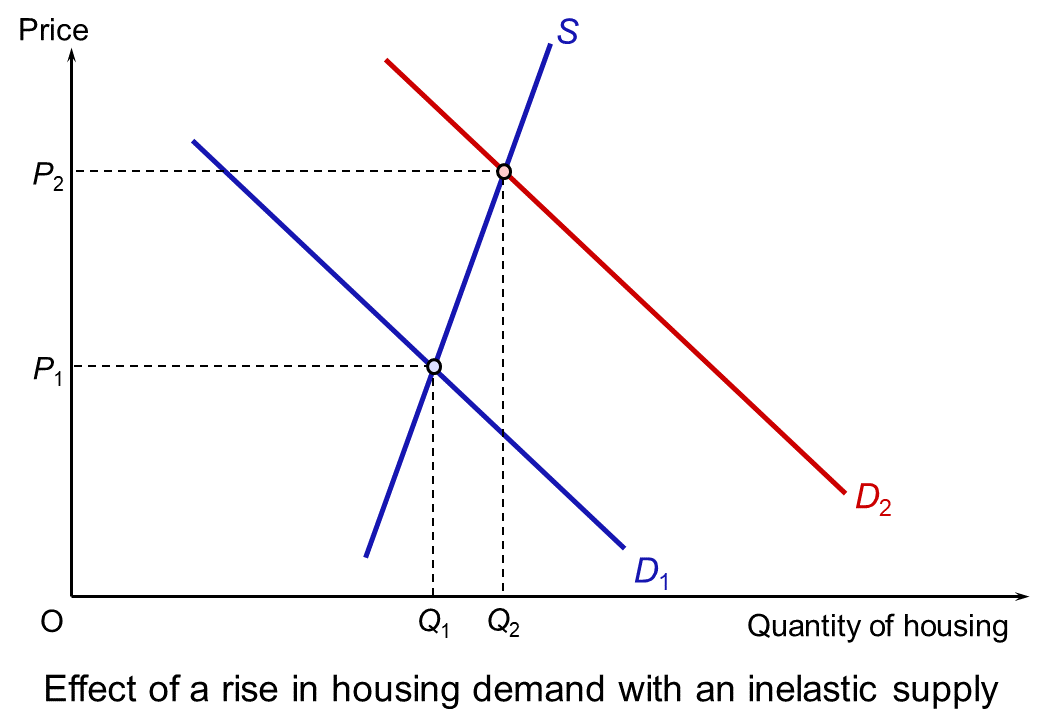 The supply of new housing in the short run is price inelastic. The main reason for this is the time it takes to build a new home. The production of a house can take many months, from the planning process to the project’s completion. Supply also relies on access to a skilled labour force and the availability of certain construction materials.
The supply of new housing in the short run is price inelastic. The main reason for this is the time it takes to build a new home. The production of a house can take many months, from the planning process to the project’s completion. Supply also relies on access to a skilled labour force and the availability of certain construction materials.
Because of the inelastic supply, any changes in demand are likely to have a significant effect on price. This is illustrated by the diagram, which shows a larger proportionate increase in price than quantity when demand increases from D1 to D2.
The current UK housing market
Despite the current economic climate and the effects of the lockdown restrictions on consumers, house prices have increased, and sales have now resumed. Rightmove, which advertises 95% of homes for sale, states that the housing market has seen its busiest month in more than 10 years in July. During the summer, the housing market usually sees a lull in activity. However, since the easing of lockdown, there has been a flurry of activity from buyers and sellers. Since July 2019, house prices have increased by 1.7%, according to the Nationwide Building Society.
 London estate agency, Hamptons, states that homeowners are now bringing forward their moving plans as the experience of lockdown has encouraged them to seek more space. The mortgage market is also very favourable right now in terms of interest rates, and rental demand is continuing to surge across the UK.
London estate agency, Hamptons, states that homeowners are now bringing forward their moving plans as the experience of lockdown has encouraged them to seek more space. The mortgage market is also very favourable right now in terms of interest rates, and rental demand is continuing to surge across the UK.
The increase in activity in the market has also been helped by the announcement of a stamp duty ‘holiday’ until March 2021. This sees the threshold above which stamp duty is paid rising from £125 000 to £500 000. Estate agency, Savills, has also seen an increase in the number of new buyers registering with its service, more than double the number registered in July 2019. It is thought that, along with the tax savings from stamp duty, people’s experiences in lockdown have made them evaluate their current living space and reconsider their housing needs.
However, given the that the economy is experiencing its deepest recession on record, there is concern about just how long the market can resist the economic forces pulling prices down.
Historically, a drop in house prices has been both a cause and a consequence of economic recessions. During the 2008 financial crisis, house prices fell by about 30%. As previously mentioned, for the majority of people, a house is the most valuable thing they will ever own and therefore consumers are extremely interested in its value. Consumer confidence is one of the key factors affecting the demand for housing. If consumers feel pessimistic about the future state of the economy, they will be less likely to go ahead with purchasing a house, thereby decreasing demand. Britain’s Office for Budget Responsibility, the country’s fiscal watchdog, forecasts that during this downturn prices will fall 5% this year and 11% in 2021.
Various government schemes put in place to help during lockdown are starting to come to an end. The main one – the furlough scheme, which replaced 80% of eligible workers’ incomes – comes to an end in October. It is forecast that labour market conditions will weaken significantly in the quarters ahead, with unemployment predicted to rise for the rest of the year. If these predictions materialise, it would likely dampen housing activity once again.
Conclusion
Fluctuations in house prices and transactions tend to amplify the volatility of the economic cycle. Therefore, it is crucial that we understand what influences such changes. Understanding how supply and demand factors influence the housing market can enable key stakeholders to make better predictions about future activity and plan accordingly. The current market has seen a growth since the easing of restrictions but there is concern that this has been powered by pent-up demand. Therefore, the outlook for house prices is uncertain and the full effects of an economic downturn are yet to be realised.
Articles
Questions
- Explain why the supply of housing is inelastic in the short-term.
- Given that the elasticity of housing supply in the UK is low, what policies could be introduced to ensure that house building is more responsive to changes in market demand?
- If unemployment does increase as predicted, explain what impact this would have on the demand in the housing market and house prices? Use a supply and demand diagram to aid your answer.
- Explain how changes in house prices affect the government’s key macroeconomic objectives.
 Share prices are determined by demand and supply. The same applies to stock market indices, such as the FTSE 100 and FTSE 250 in the UK and the Dow Jones Industrial Average and the S&P 500 in the USA. After all, the indices are the weighted average prices of the shares included in the index. Generally, when economies are performing well, or are expected to do so, share prices will rise. They are likely to fall in a recession or if a recession is anticipated. A main reason for this is that the dividends paid on shares will reflect the profitability of firms, which tends to rise in times of a buoyant economy.
Share prices are determined by demand and supply. The same applies to stock market indices, such as the FTSE 100 and FTSE 250 in the UK and the Dow Jones Industrial Average and the S&P 500 in the USA. After all, the indices are the weighted average prices of the shares included in the index. Generally, when economies are performing well, or are expected to do so, share prices will rise. They are likely to fall in a recession or if a recession is anticipated. A main reason for this is that the dividends paid on shares will reflect the profitability of firms, which tends to rise in times of a buoyant economy.
When it first became clear that Covid-19 would become a pandemic and as countries began locking down, so stock markets plummeted. People anticipated that many businesses would fail and that the likely recession would cause profits of many other surviving firms to decline rapidly. People sold shares.
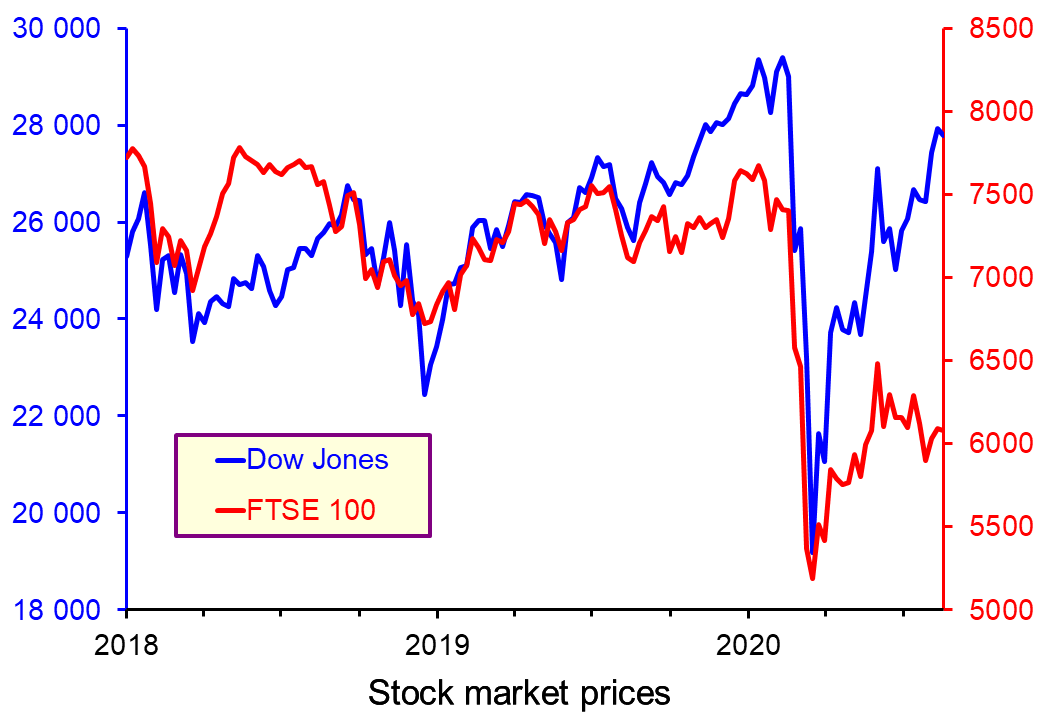 The first chart shows how the FTSE 100 fell from 7466 in early February 2020 to 5190 in late March, a fall of 30.5%. The Dow Jones fell by 34% over the same period. In both cases the fall was driven not only by the decline in the respective economy over the period, but by speculation that further declines were to come (click here for a PowerPoint of the chart).
The first chart shows how the FTSE 100 fell from 7466 in early February 2020 to 5190 in late March, a fall of 30.5%. The Dow Jones fell by 34% over the same period. In both cases the fall was driven not only by the decline in the respective economy over the period, but by speculation that further declines were to come (click here for a PowerPoint of the chart).
But then stock markets started rising again, especially the Dow Jones, despite the fact that the recessions in the UK, the USA and other countries were gathering pace. In the second quarter of 2020, the Dow Jones rose by 23% and yet the US economy declined by 33% – the biggest quarterly decline on record. How could this be explained by supply and demand?
Quantitative easing
In order to boost aggregate demand and reduce the size of the recession, central banks around the world engaged in large-scale quantitative easing. 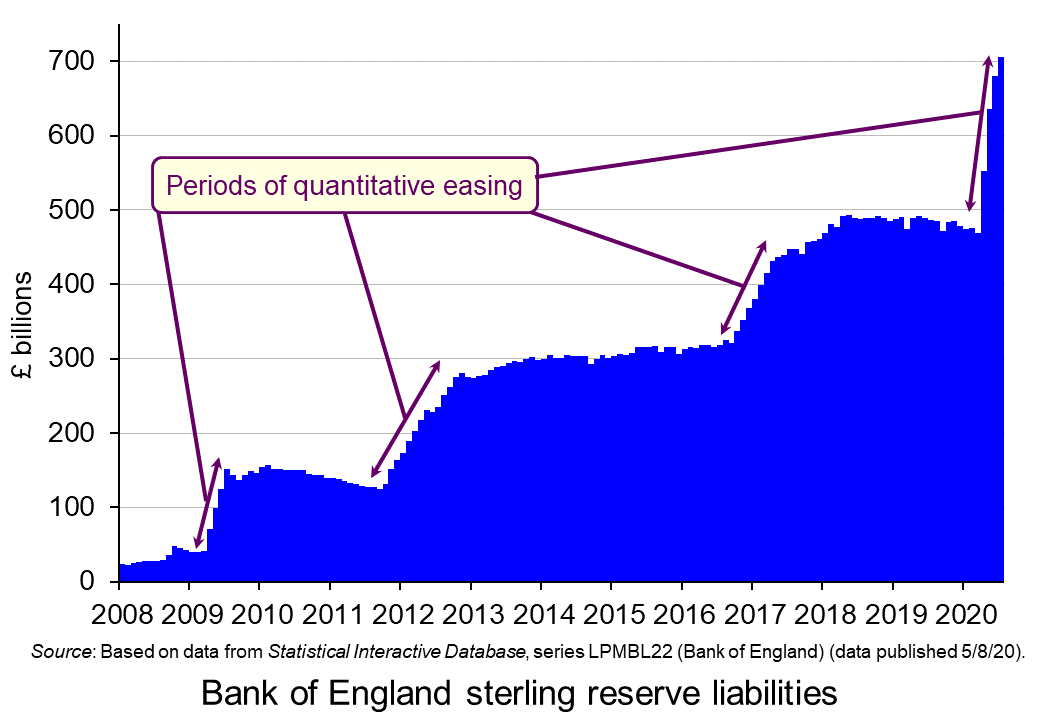 This involves central banks buying government bonds and possibly corporate bonds too with newly created money. The extra money is then used to purchase other assets, such as stocks and shares and property, or physical capital or goods and services. The second chart shows that quantitative easing by the Bank of England increased the Bank’s asset holding from April to July 2020 by 50%, from £469bn to £705bn (click here for a PowerPoint of the chart).
This involves central banks buying government bonds and possibly corporate bonds too with newly created money. The extra money is then used to purchase other assets, such as stocks and shares and property, or physical capital or goods and services. The second chart shows that quantitative easing by the Bank of England increased the Bank’s asset holding from April to July 2020 by 50%, from £469bn to £705bn (click here for a PowerPoint of the chart).
But given the general pessimism about the state of the global economy, employment and personal finances, there was little feed-through into consumption and investment. Instead, most of the extra money was used to buy assets. This gave a huge boost to stock markets. Stock market movements were thus out of line with movements in GDP.
Confidence
Stock market prices do not just reflect the current economic and financial situation, but also what people anticipate the situation to be in the future. 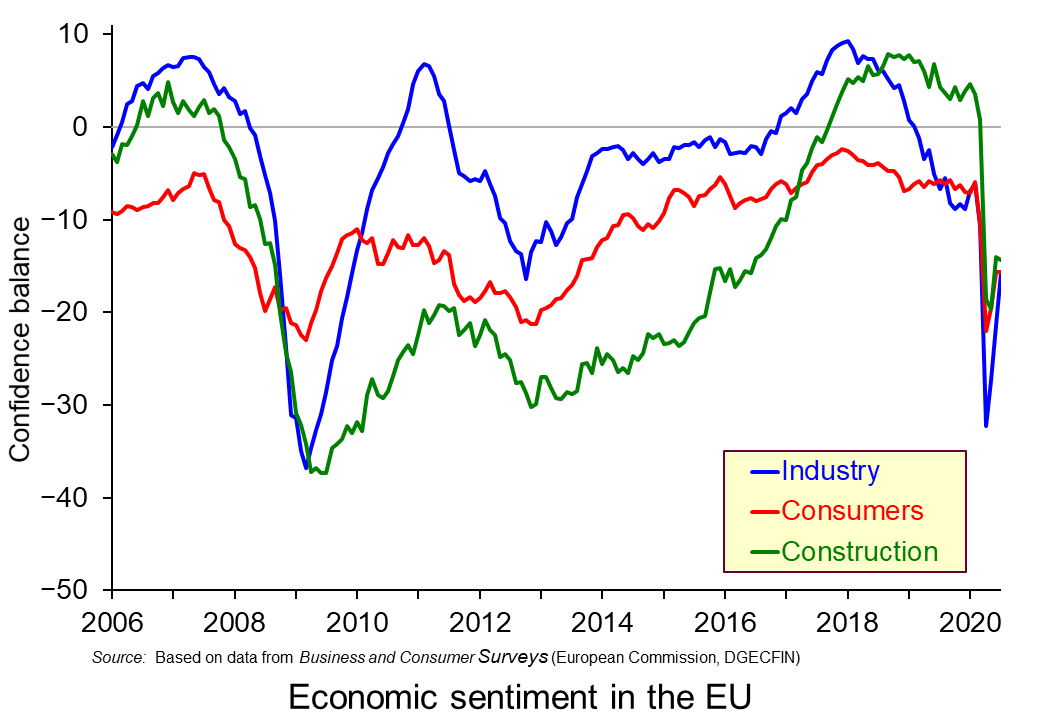 As infection and death rates from Covid-19 waned around Europe and in many other countries, so consumer and business confidence rose. This is illustrated in the third chart, which shows industrial, consumer and construction confidence indicators in the EU. As you can see, after falling sharply as the pandemic took hold in early 2020 and countries were locked down, confidence then rose (click here for a PowerPoint of the chart).
As infection and death rates from Covid-19 waned around Europe and in many other countries, so consumer and business confidence rose. This is illustrated in the third chart, which shows industrial, consumer and construction confidence indicators in the EU. As you can see, after falling sharply as the pandemic took hold in early 2020 and countries were locked down, confidence then rose (click here for a PowerPoint of the chart).
But, as infection rates have risen somewhat in many countries and continue to soar in the USA, Brazil, India and some other countries, this confidence may well start to fall again and this could impact on stock markets.
Speculation
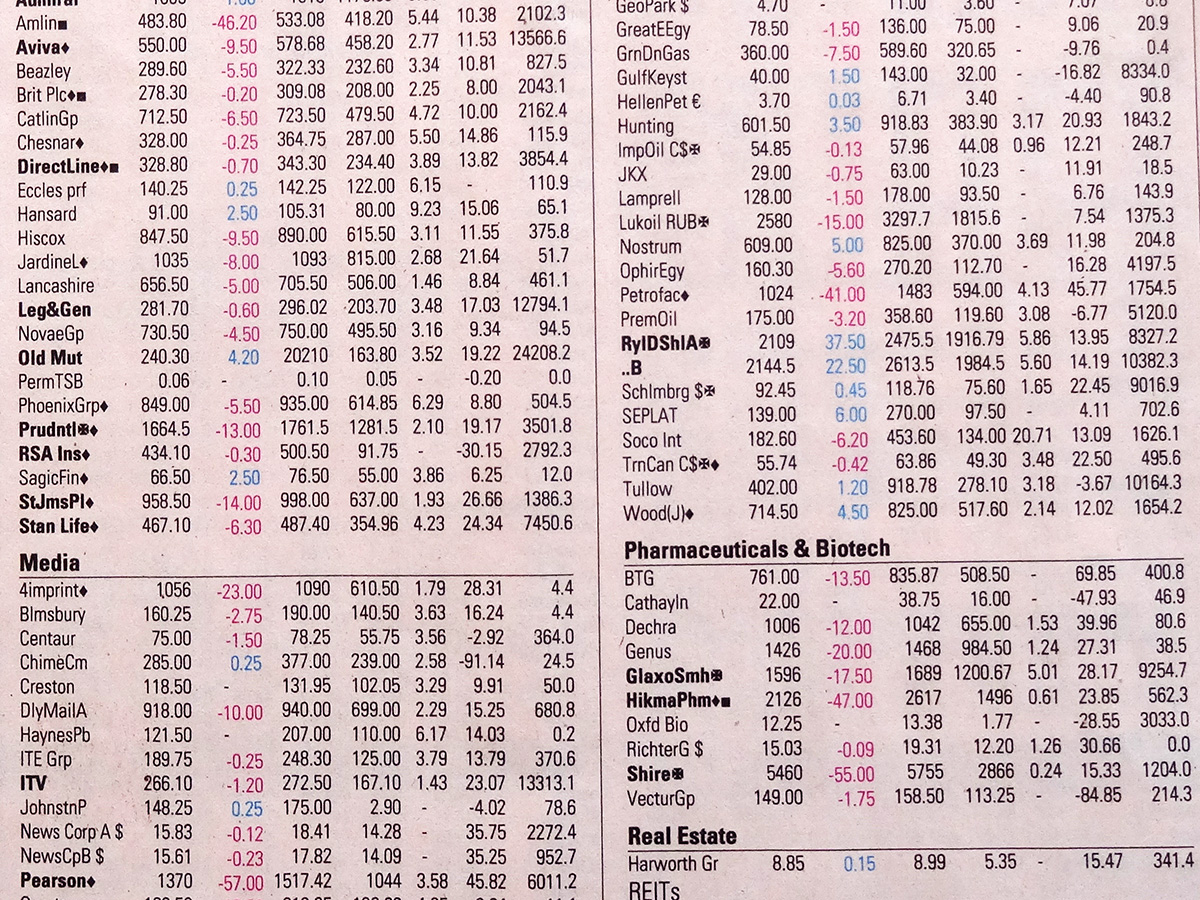 A final, but related, cause of recent stock market movements is speculation. If people see share prices falling and believe that they are likely to fall further, then they will sell shares and hold cash or safer assets instead. This will amplify the fall and encourage further speculation. If, however, they see share prices rising and believe that they will continue to do so, they are likely to want to buy shares, hoping to make a gain by buying them relatively cheaply. This will amplify the rise and, again, encourage further speculation.
A final, but related, cause of recent stock market movements is speculation. If people see share prices falling and believe that they are likely to fall further, then they will sell shares and hold cash or safer assets instead. This will amplify the fall and encourage further speculation. If, however, they see share prices rising and believe that they will continue to do so, they are likely to want to buy shares, hoping to make a gain by buying them relatively cheaply. This will amplify the rise and, again, encourage further speculation.
If there is a second wave of the pandemic, then stock markets could well fall again, as they could if speculators think that share prices have overshot the levels that reflect the economic and financial situation. But then there may be even further quantitative easing.
There are many uncertainties, both with the pandemic and with governments’ policy responses. These make forecasting stock market movements very difficult. Large gains or large losses could await people speculating on what will happen to share prices.
Articles
Questions
- Illustrate the recent movements of stock markets using demand and supply diagrams. Explain your diagrams.
- What determines the price elasticity of demand for shares?
- Distinguish between stabilising and destabilising speculation. How are the concepts relevant to the recent history of stock market movements?
- Explain how quantitative easing works to increase (a) asset prices; (b) aggregate demand.
- What is the difference between quantitative easing as currently conducted by central banks and ‘helicopter money‘?
- Give some examples of companies whose share prices have risen strongly since March 2020. Explain why these particular shares have done so well.
 Rishi Sunak delivered his 2021 UK Budget on 3 March. It illustrates the delicate balancing act that governments in many countries face as the effects of the coronavirus pandemic persist and public-sector debt soars. He announced that he would continue supporting the economy through various forms of government expenditure and tax relief, but also announced tax rises over the medium term to begin addressing the massively increased public-sector debt.
Rishi Sunak delivered his 2021 UK Budget on 3 March. It illustrates the delicate balancing act that governments in many countries face as the effects of the coronavirus pandemic persist and public-sector debt soars. He announced that he would continue supporting the economy through various forms of government expenditure and tax relief, but also announced tax rises over the medium term to begin addressing the massively increased public-sector debt.
 Faced with this big increase in borrowing, the Chancellor also announced some measures to raise tax revenue beginning in two years’ time when, hopefully, the economy will have grown. Indeed, the OBR forecasts that GDP will grow by 4.0% in 2021 and 7.3% in 2022, with the growth rate then settling at around 1.7% from 2023 onwards. He announced that:
Faced with this big increase in borrowing, the Chancellor also announced some measures to raise tax revenue beginning in two years’ time when, hopefully, the economy will have grown. Indeed, the OBR forecasts that GDP will grow by 4.0% in 2021 and 7.3% in 2022, with the growth rate then settling at around 1.7% from 2023 onwards. He announced that: The policy of a fiscal boost now and a fiscal tightening later might pose political difficulties for the government as this does not fit with the electoral cycle. Normally, politicians like to pursue tighter policies in the early years of the government only to loosen policy with various giveaways as the next election approaches. With Rishi Sunak’s policies, the opposite is the case, with fiscal policy being tightened as the 2024 election approaches.
The policy of a fiscal boost now and a fiscal tightening later might pose political difficulties for the government as this does not fit with the electoral cycle. Normally, politicians like to pursue tighter policies in the early years of the government only to loosen policy with various giveaways as the next election approaches. With Rishi Sunak’s policies, the opposite is the case, with fiscal policy being tightened as the 2024 election approaches. Budget 2021
Budget 2021 Budget 2021: Prepare for a dramatic rollercoaster ride after chancellor’s give-then-take budget
Budget 2021: Prepare for a dramatic rollercoaster ride after chancellor’s give-then-take budget According to the central forecast, real GDP is set to decline by 11.3% in 2020, the largest one-year fall since the Great Frost of 1709. The economy is then set to ‘bounce back’ (somewhat), with GDP rising by 5.2% in 2021.
According to the central forecast, real GDP is set to decline by 11.3% in 2020, the largest one-year fall since the Great Frost of 1709. The economy is then set to ‘bounce back’ (somewhat), with GDP rising by 5.2% in 2021. 
 Indeed, there is pressure to have higher government expenditure over the longer term to finance infrastructure investment – something supported by the Conservative government.
Indeed, there is pressure to have higher government expenditure over the longer term to finance infrastructure investment – something supported by the Conservative government. 4. Higher growth ‘deals’ with the deficit and reduces debt. In this scenario, austerity would be unnecessary. This is the ‘golden’ scenario – for the country to grow its way out of the problem. Higher output and incomes leads to higher tax revenues, and lower unemployment leads to lower expenditure on unemployment benefits. The crucial question is the relationship between aggregate demand and supply. For growth to be sustainable and shrink the debt/GDP ratio, aggregate demand must expand steadily in line with the growth in aggregate supply. The faster aggregate supply can grow, the faster can aggregate demand. In other words, the faster the growth in potential GDP, the faster can be the sustainable rate of growth of actual GDP and the faster can the debt/GDP ratio shrink.
4. Higher growth ‘deals’ with the deficit and reduces debt. In this scenario, austerity would be unnecessary. This is the ‘golden’ scenario – for the country to grow its way out of the problem. Higher output and incomes leads to higher tax revenues, and lower unemployment leads to lower expenditure on unemployment benefits. The crucial question is the relationship between aggregate demand and supply. For growth to be sustainable and shrink the debt/GDP ratio, aggregate demand must expand steadily in line with the growth in aggregate supply. The faster aggregate supply can grow, the faster can aggregate demand. In other words, the faster the growth in potential GDP, the faster can be the sustainable rate of growth of actual GDP and the faster can the debt/GDP ratio shrink. Back in June,
Back in June,  In essence the picture is similar to that painted in April. The IMF predicts a large-scale fall in GDP and rise in unemployment, government borrowing and government debt for 2020 (compared with 2019) across virtually all countries.
In essence the picture is similar to that painted in April. The IMF predicts a large-scale fall in GDP and rise in unemployment, government borrowing and government debt for 2020 (compared with 2019) across virtually all countries.  There will then be somewhat of a ‘bounce back’ in GDP in 2021, but not to the levels of 2019. World real GDP is predicted to rise by 5.2% in 2021. (Click
There will then be somewhat of a ‘bounce back’ in GDP in 2021, but not to the levels of 2019. World real GDP is predicted to rise by 5.2% in 2021. (Click  Inflation is set to fall from already low levels. Several countries are expected to see falling prices.
Inflation is set to fall from already low levels. Several countries are expected to see falling prices.  Government debt will consequently rise more rapidly. Deficits are predicted to fall in 2021 as economies recover and hence the rise in debt will slow down or in some cases, such as Germany, even fall. (Click
Government debt will consequently rise more rapidly. Deficits are predicted to fall in 2021 as economies recover and hence the rise in debt will slow down or in some cases, such as Germany, even fall. (Click  In the short term, the greatest uncertainty concerns the extent of the second wave, the measures put in place to contain the spread of the virus and the compensation provided by governments to businesses and workers. The WEO report was prepared when the second wave was only just beginning. It could well be that countries will experience a deeper recession in 2000 and into 2021 than predicted by the IMF.
In the short term, the greatest uncertainty concerns the extent of the second wave, the measures put in place to contain the spread of the virus and the compensation provided by governments to businesses and workers. The WEO report was prepared when the second wave was only just beginning. It could well be that countries will experience a deeper recession in 2000 and into 2021 than predicted by the IMF. One of the greatest uncertainties in the medium term concerns the stance of fiscal and monetary policies. Will governments continue to run large deficits to support demand or will they attempt to reduce deficits by raising taxes and/or reducing benefits and/or cutting government current or capital expenditure?
One of the greatest uncertainties in the medium term concerns the stance of fiscal and monetary policies. Will governments continue to run large deficits to support demand or will they attempt to reduce deficits by raising taxes and/or reducing benefits and/or cutting government current or capital expenditure?  For the majority of people, a house (or flat) is the most valuable thing they will ever own.
For the majority of people, a house (or flat) is the most valuable thing they will ever own. Changes in the housing market are always given such importance due to the relationship house prices have with consumer spending. Changes in house prices and the number of sales affect how much money people have to spend. Given that household spending accounts for two-thirds of Britain’s total economic activity, any changes in consumption is likely to have a major impact on the wider economy. Observing the housing market helps us to assess the overall demand for goods and services.
Changes in the housing market are always given such importance due to the relationship house prices have with consumer spending. Changes in house prices and the number of sales affect how much money people have to spend. Given that household spending accounts for two-thirds of Britain’s total economic activity, any changes in consumption is likely to have a major impact on the wider economy. Observing the housing market helps us to assess the overall demand for goods and services. The first is when a new build is purchased. This directly contributes to GDP through the investment in the land to build the house on, the purchase of materials and the creation of jobs. Once the homeowners move in they also contribute to the local economy: i.e. shopping at local shops.
The first is when a new build is purchased. This directly contributes to GDP through the investment in the land to build the house on, the purchase of materials and the creation of jobs. Once the homeowners move in they also contribute to the local economy: i.e. shopping at local shops.  The supply of new housing in the short run is price inelastic. The main reason for this is the time it takes to build a new home. The production of a house can take many months, from the planning process to the project’s completion. Supply also relies on access to a skilled labour force and the availability of certain construction materials.
The supply of new housing in the short run is price inelastic. The main reason for this is the time it takes to build a new home. The production of a house can take many months, from the planning process to the project’s completion. Supply also relies on access to a skilled labour force and the availability of certain construction materials.  London estate agency, Hamptons, states that homeowners are now bringing forward their moving plans as the experience of lockdown has encouraged them to seek more space. The mortgage market is also very favourable right now in terms of interest rates, and rental demand is continuing to surge across the UK.
London estate agency, Hamptons, states that homeowners are now bringing forward their moving plans as the experience of lockdown has encouraged them to seek more space. The mortgage market is also very favourable right now in terms of interest rates, and rental demand is continuing to surge across the UK.  Share prices are determined by demand and supply. The same applies to stock market indices, such as the
Share prices are determined by demand and supply. The same applies to stock market indices, such as the  The first chart shows how the FTSE 100 fell from 7466 in early February 2020 to 5190 in late March, a fall of 30.5%. The Dow Jones fell by 34% over the same period. In both cases the fall was driven not only by the decline in the respective economy over the period, but by speculation that further declines were to come (click
The first chart shows how the FTSE 100 fell from 7466 in early February 2020 to 5190 in late March, a fall of 30.5%. The Dow Jones fell by 34% over the same period. In both cases the fall was driven not only by the decline in the respective economy over the period, but by speculation that further declines were to come (click  This involves central banks buying government bonds and possibly corporate bonds too with newly created money. The extra money is then used to purchase other assets, such as stocks and shares and property, or physical capital or goods and services. The second chart shows that quantitative easing by the Bank of England increased the Bank’s asset holding from April to July 2020 by 50%, from £469bn to £705bn (click
This involves central banks buying government bonds and possibly corporate bonds too with newly created money. The extra money is then used to purchase other assets, such as stocks and shares and property, or physical capital or goods and services. The second chart shows that quantitative easing by the Bank of England increased the Bank’s asset holding from April to July 2020 by 50%, from £469bn to £705bn (click  As infection and death rates from Covid-19 waned around Europe and in many other countries, so consumer and business confidence rose. This is illustrated in the third chart, which shows industrial, consumer and construction confidence indicators in the EU. As you can see, after falling sharply as the pandemic took hold in early 2020 and countries were locked down, confidence then rose (click
As infection and death rates from Covid-19 waned around Europe and in many other countries, so consumer and business confidence rose. This is illustrated in the third chart, which shows industrial, consumer and construction confidence indicators in the EU. As you can see, after falling sharply as the pandemic took hold in early 2020 and countries were locked down, confidence then rose (click  A final, but related, cause of recent stock market movements is speculation. If people see share prices falling and believe that they are likely to fall further, then they will sell shares and hold cash or safer assets instead. This will amplify the fall and encourage further speculation. If, however, they see share prices rising and believe that they will continue to do so, they are likely to want to buy shares, hoping to make a gain by buying them relatively cheaply. This will amplify the rise and, again, encourage further speculation.
A final, but related, cause of recent stock market movements is speculation. If people see share prices falling and believe that they are likely to fall further, then they will sell shares and hold cash or safer assets instead. This will amplify the fall and encourage further speculation. If, however, they see share prices rising and believe that they will continue to do so, they are likely to want to buy shares, hoping to make a gain by buying them relatively cheaply. This will amplify the rise and, again, encourage further speculation.